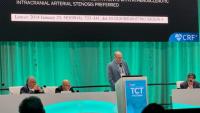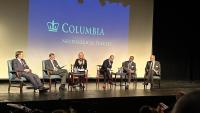Stroke
Make an Appointment
Our team of dedicated access representatives is here to help you make an appointment with the specialists that you need.
During a stroke, blood vessel blockage or bleeding in the brain interferes with the systems that ordinarily provide oxygen and nutrients to brain tissue. The brain can incur damage as a result in a short period of time. Stroke treatment varies by the type of stroke, its location, severity, and many other factors. Our highly trained, experienced neurosurgeons tailor their stroke treatment plans to provide each patient the best possible chance at maximum recovery.
Whenever possible, patients with a stroke should be treated by a specialized, experienced stroke team at a comprehensive stroke center like the one at Columbia University Irving Medical Center/NewYork-Presbyterian Hospital.
Doctors classify strokes based on their causes: either hemorrhagic or ischemic.
Hemorrhagic stroke occurs when a blood vessel ruptures and bleeds. (Uncontrolled bleeding is called a hemorrhage.) When a blood vessel hemorrhages, the cells, and tissues typically supplied by that vessel do not receive the oxygen and nutrients they need. In addition, the escaped blood causes pressure to build up in surrounding tissues, which may cause irritation, swelling and potentially a cascade of additional effects. Thus a hemorrhagic stroke may have both immediate and delayed consequences. About 13 percent of strokes are hemorrhagic.
Hemorrhagic strokes can be further classified based on location:
- Intracerebral hemorrhage: Bleeding is from the blood vessels within the brain. Accounts for about 10 percent of all strokes.
- Subarachnoid hemorrhage: Bleeding is in the subarachnoid space, in the protective membranes around the brain that contain the cerebrospinal fluid. Accounts for about 3 percent of all strokes.
Ischemic stroke occurs when blood flow to an area is compromised. Without blood flow, the cells and tissues in the affected area of the brain are starved of oxygen and nutrients. About 87 percent of strokes are ischemic strokes. Most strokes result from an embolism that travels from the heart, aorta, or carotid or vertebral arteries and becomes lodged in a brain artery blocking blood flow to a region of the brain.
Transient ischemic attacks (TIAs) are sometimes called mini-strokes. They occur when blood flow is interrupted for a short time and is then restored. The symptoms of a TIA are the same as those of a stroke. In a TIA, blood flow returns before the damage becomes permanent, and the symptoms recede on their own. TIAs are sometimes called “warning” strokes, as they often indicate an increased risk of an impending major stroke.
Symptoms
Symptoms of stroke vary. The most common symptoms are:
- Sudden numbness, weakness or paralysis, especially on one side of the face or body
- Sudden trouble speaking or understanding
- Sudden changes in vision, such as blurriness, dim vision, or double vision
- Sudden loss of coordination, or trouble with balance or walking
- Sudden major headache, which may be accompanied by nausea or vomiting
- Sudden loss of consciousness
Even if symptoms resolve on their own, it is still important to get prompt medical attention to address possible increased risk for a full-blown stroke—a leading cause of death and disability in the United States.
When it comes to stroke treatment, “time is brain.” Fast treatment is essential for achieving the best possible outcome.
In fact, one common way to remember signs of a stroke incorporates the acronym FAST:
- Face drooping? (To check symptoms in another person, ask him or her to smile.)
- Arm weakness? (Ask the person to raise both arms.)
- Speech trouble? (Ask the person to repeat a simple phrase or tell you the day of the week.)
- Time to call 911. (Don’t delay.)
Diagnosis
When a patient experiences symptoms that may indicate a stroke, physicians must determine whether the symptoms are due to stroke, tumor, a drug reaction, an injury or other factors. Doctors take into account these and other considerations when deciding which tests to perform and when.
When possible, the doctor will need to know when and how symptoms began, whether the patient has diabetes or other risk factors for stroke, and whether the patient has had a stroke in the past. The medical team may take the patient’s blood pressure and check for carotid artery disease by listening to the blood flow through the arteries in the neck. Blood may be drawn for blood tests. If stroke is a likely diagnosis, the next step may be an imaging test such as:
- Magnetic resonance scan (MR scan, MRI): Uses magnets, radio waves and a computer to form images of the body’s structures
- Computed tomography scan (CT scan, CAT scan): Uses a computer and X-rays taken from a variety of angles to form images of the body’s structures
- Ultrasound: Uses sound waves to form images of the inside of the carotid arteries (arteries in the neck)
- Angiogram: Uses a dye that travels through the bloodstream to create images of blood flow
- Echocardiogram: Uses sound waves to create images of the heart, including any blood clots
Risk Factors
Ischemic strokes are often caused by an abnormal heart rhythm (such as atrial fibrillation, or “a-fib”), atherosclerosis, carotid artery disease or another artery disorder.
Intracerebral and subarachnoid hemorrhages may be caused by high blood pressure, a burst aneurysm or a burst AVM.
In general, risk factors for stroke include:
- High blood pressure
- High cholesterol
- Diabetes
- Obesity
- Smoking or using other tobacco products
- Atrial fibrillation
Treatments
Stroke treatment varies depending on the type of stroke, its location, its severity, its cause and the patient’s overall health.
A variety of surgical and endovascular treatments are available. Options may include:
- Clipping: Placing a clip that squeezes an aneurysm’s blood supply closed
- Coiling: Filling an aneurysm with tiny metal coils that encourage blood to clot
- Flow diversion: Inserting a tube that directs blood flow past a coiled aneurysm
- Embolization: Injecting a glue-like substance that encourages blood to clot
- Resection: Removing the affected vessel
- Radiosurgery: Delivering precise beams of radiation that slowly shut down the affected vessels
- Hematoma removal: Removing an accumulation of dried blood that puts pressure on brain tissues
Columbia University Irving Medical Center/NewYork-Presbyterian Hospital has been designated as a Comprehensive Stroke Center. This means that there are neurologists, neurosurgeons, and neuroendovascular therapists available 24 hours a day, 7 days a week, and 365 days a year to treat stroke patients.
Recent medical studies and literature have proven the effectiveness of endovascular therapy for the treatment of stroke. NewYork-Presbyterian has a dedicated Stroke Mobile Unit Ambulance that gives our patients the most efficient way to get this life-saving treatment.




